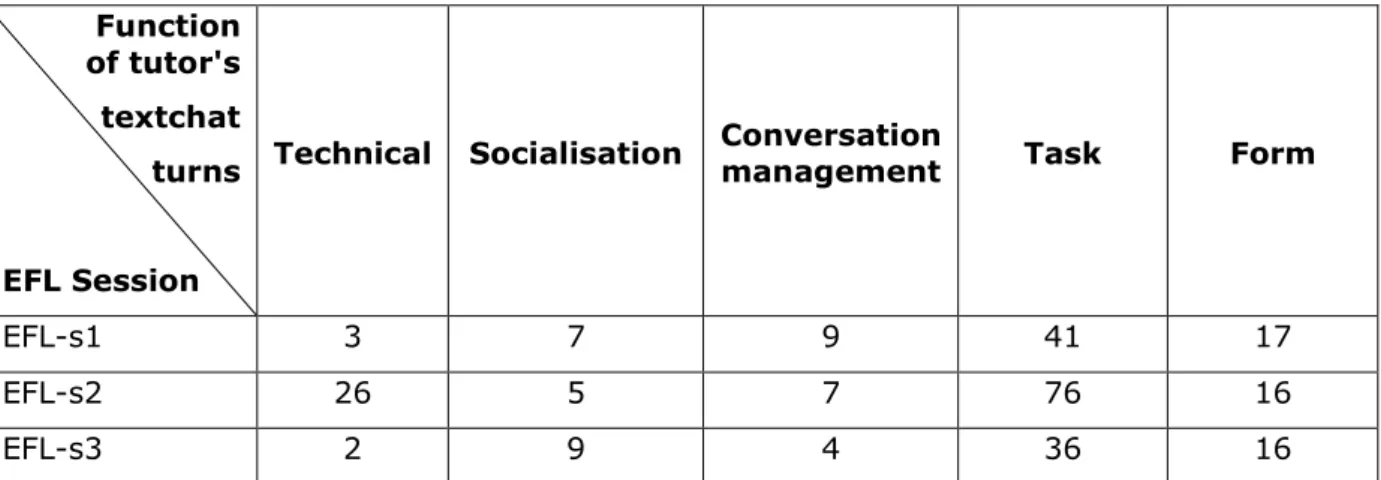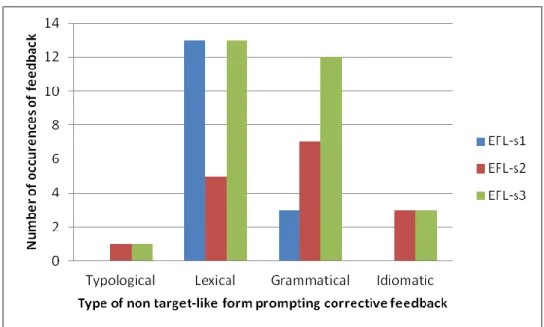HAL Id: hal-00660865
https://hal.archives-ouvertes.fr/hal-00660865v2
Submitted on 1 Jun 2012
HAL is a multi-disciplinary open access
archive for the deposit and dissemination of
sci-entific research documents, whether they are
pub-lished or not. The documents may come from
teaching and research institutions in France or
abroad, or from public or private research centers.
L’archive ouverte pluridisciplinaire HAL, est
destinée au dépôt et à la diffusion de documents
scientifiques de niveau recherche, publiés ou non,
émanant des établissements d’enseignement et de
recherche français ou étrangers, des laboratoires
publics ou privés.
Interactions between text chat and audio modalities for
L2 communication in the synthetic world Second Life.
Ciara R. Wigham, Thierry Chanier
To cite this version:
Ciara R. Wigham, Thierry Chanier. Interactions between text chat and audio modalities for L2
communication in the synthetic world Second Life.. 15th International CALL Research Conference,
May 2012, Taichung, Taiwan. �hal-00660865v2�
CALL 2012 - The Medium Matters
_____________________________________________________________
AUTHORNAME(S):CIARA R.WIGHAM,THIERRY CHANIER
AFFILIATION AND ADDRESS:CLERMONT UNIVERSITE, LABORATOIRE DE RECHERCHE SUR LE LANGAGE,MAISON DES SCIENCES DE L’HOMME,4 RUE LEDRU,63057CLERMONT-FERRAND CEDEX 01,FRANCE.
E-MAIL ADDRESS:CIARA.WIGHAM@UNIV-BPCLERMONT.FR;THIERRY.CHANIER@UNIV -BPCLERMONT.FR
BIO DATA:
Ciara R. Wigham is a doctoral student and English language teacher at Université Blaise Pascal, Clermont-Ferrand, France. Her PhD research concerns Content and Language Integrated Learning (CLIL) in synthetic worlds and focuses on how multimodal pedagogical communication is organised within such environments.
Thierry Chanier is Professor of Applied Linguistics at Université Blaise Pascal, Clermont-Ferrand, France. His main research interest over the past 20 years has been CALL and, since 1999, online learning in telecollaborative situations. He coordinated the Mulce project which developed an open-access repository of LEarning & TEaching Corpora. ___________________________________________________________________
PAPER FOR PRESENTATION
TITLE:INTERACTIONS BETWEEN TEXTCHAT AND AUDIO MODALITIES FOR L2 COMMUNICATION IN THE SYNTHETIC WORLD SECOND LIFE.
KEYWORDS: SYNTHETIC WORLDS, MULTIMODALITY, TEXTCHAT, CORRECTIVE FEEDBACK
ABSTRACT:
The interest in synthetic worlds for both language education (Molka-Danielson &
Deutschmann, 2009) and architectural design (Gu. et al., 2009), coupled with the need of architects to develop adequate foreign language (L2) skills facilitating mobility and employability, led to the design of "Building Fragile Spaces." This hybrid Content and Language Integrated Learning (CLIL) course was held in Spring 2011. It included distance French and English L2 activities, conducted in the synthetic world Second Life, which incorporated both architectural and linguistic objectives.
Our study of the "Building Fragile Spaces" course sheds light on how communication in the synthetic world is organised for pedagogical purposes. We focus on the usage and interaction between the textchat and audio modalities. Our analysis employs data provided from multimodal transcriptions of six group reflective sessions, transcribed according to a predefined methodology (Wigham & Chanier, in print). We show how, depending on the tutor's stance towards the texchat, turns in the textchat modality can help structure and support the L2 interactions. We also describe the use of the textchat modality by one tutor for linguistic correction and the incorporation of these corrections in the students' discourse.
SHORT PAPER:
In synchronous audiographic environments which combine voicechat and textchat, there is a general assumption that the textchat modality acts in adjunct to the audio modality. For example, when technical problems exist or in sessions' opening and closing
sequences (Liddicoat, 2011; Palomeque, 2011). Often, tutors are wary that using
main activity (Deutschmann & Panichi, 2009). Our previous work (Chanier & Vetter, 2006) showed, although the audio modality will take precedence where language
learning is concerned, that the textchat worked in support, rather than opposition, of the audio modality. Indeed, rather than being a cognitive overload, textchat allows lower-level language learners to compensate for less active participation in the voicechat. This paper builds upon the previous study, exploring the textchat modality's role in language learning sessions conducted in the synthetic world Second Life. We further our previous conclusions by investigating whether the tutor's stance towards and usage of the textchat affects the students' use of this modality and the overall interaction in the verbal mode. Our study's focus is the course "Building Fragile Spaces" (BFS). At the core of the course was a Content and Language Integrated Learning approach where the learning of a subject, here architecture, and an additional language (L2), here English and French, are interwoven.
BFS was a hybrid five-day intensive course involving 17 undergraduate and Master’s architecture students. They worked with two architecture tutors in a face-to-face classroom environment and two language tutors, at a distance, in Second Life. The students were divided into workgroups. Two workgroups had English as their L2 (EFL, B1-B2, CEFR level) and two French (FFL, A2-B1 level). The students' macro-task was to produce an inworld model to respond to a architectural problem brief concerning the theme of land+scapes, (e)spaces, avatars or scenarios. Second Life was, thus, at the heart of the course’s architectural content.
The L2 learning design was articulated around the architectural learning design (Foucher
et al., 2011). It included introductory sessions to Second Life, a building jigsaw activity,
and a series of Second Life group reflective sessions. This study focuses on six of these latter sessions. Their primary objective was for students to articulate and deepen their understanding of their group’s workshop process by recalling and describing in their L2 the information given by architecture teachers, inferring the relevance of this information and identifying future directions for the development of their project work. The language tutors' role in this open-task was to animate the discussion and help the group advance in response to the problem brief, despite the field of architecture not being an area of expertise. A further question is, thus, given the context, whether it is possible for the tutors to provide corrective feedback concerning non target-like forms in the students' productions and using which modality.
Concerning data collection, researchers present in Second Life observed all sessions and recorded screen and audio output. Text-chat logs were saved. These data, alongside the learning design and research protocol, were structured into an open-access LEarning and TEaching Corpus (Chanier & Wigham, 2011). Multimodal transcriptions were then
completed, adhering to a predefined methodology (Wigham & Chanier, in print). For our study, six session transcriptions were quantitatively analysed and annotated. This included annotating each textchat turn depending on its function, corrective feedback in the textchat turns (with reference to Bower and Kawaguchi, 2011), non target-like forms which prompted corrective feedback and students’ responses to feedback. The data coverage for our study comprises 836 audio and 487 textchat acts, totalling 23338 tokens.
Our study shows a marked difference in the repartition of verbal turns between the audio and textchat modalities depending on the sessions' L2. In the EFL sessions, the textchat turns represented between 44% and 60% of the total number of verbal turns. In
comparison, textchat turns represented, on average, 15% of the total verbal turns in a FFL session (Figure 1).
Figure 1: Distribution of verbal turns across modalities
The EFL tutor used, on average, 24 more turns in any given session than the students. However, the students' textchat turns in each FFL session slightly outnumbered the tutor's textchat turns. Our analysis suggests the use of this modality depends on the stance of the tutor vis-à-vis the textchat's role. The FFL tutor suggests, through adopting primarily voicechat, that the textchat was not central to interaction. The students follow her behaviour. The EFL students, however, follow the EFL tutor's lead, contributing regularly to the interaction in this modality.
The textchat modality allowed the EFL tutor to address a central problem within teaching: how to balance attributing value to communicative meaning (the task) and to
comprehensible form (Table 1). The tutor adopts the textchat to advance the task in order to save face with respect to her lack of expertise in the architecture domain. However, she also uses the textchat to provide 'unobtrusive feedback' (Tsutsui, 2004), particularly concerning lexical non target-like forms (Figure 2).
Function of tutor's textchat turns
EFL Session
Technical Socialisation Conversation management Task Form
EFL-s1 3 7 9 41 17
EFL-s2 26 5 7 76 16
EFL-s3 2 9 4 36 16
Figure 2: Types of non target-like forms receiving feedback in the textchat shown per session
Students responded to 58% of the EFL tutor's textchat corrective feedback. 80% of these responses were in the voicechat, primarily in the same audio turn as the feedback trigger or in the following turn. This suggests the students continually shifted their attention between the audio and textchat interaction. In contrast, feedback in the audio modality often led to communicative breakdown.
To conclude, our study shows that if tutors consider the textchat's role as important to the interaction, the modality can be used by students and tutors to support the
voicechat. Furthermore, unlike presumptions made in other studies (Deutschmann & Panichi, 2009), corrective feedback given in the textchat enhanced, rather than disturbed, the communicative dynamics of tutor-learner interaction.
REFERENCES:
Bower, J. & Kawaguchi, S. (2011). Negotiation of meaning and corrective feedback in Japanese/English eTandem. Language Learning & Technology, 15(1), 41-71. Chanier, T. & Vetter, A. (2006). Multimodalité et expression en langue étrangère dans
une plate-forme audio synchrone, Apprentissage des Langues et Systèmes
d’Information et Communication (Alsic), 9, 61-101.
Chanier, T., & Wigham, C.R. (2011). (Eds.) Learning and Teaching Corpus (LETEC) of
ARCHI21. Mulce.org: Clermont Université. [oai : mulce.org:mce-archi21-letec-all;
http://repository.mulce.org]
Deutschmann, M. & Panichi, L. (2009). Instructional design, learner modelling, and teacher practice in Second Life. In J. Molka-Danielsen and M. Deutschmann. (Eds.)
Learning and Teaching in the Virtual World of Second Life. Tapir Academic Press:
Norway, 27-44.
Foucher, A.-L., Chanier, T., Rodrigues, C., Fynn, J., Bayle, A. & Wigham, C.R. (2011). What learning scenarios for virtual worlds and CLIL ?, European Computer Assisted
Language Learning Conference 2011, 31 August - 3 September, Nottingham:
United Kingdom. [http://hal.archives-ouvertes.fr/hal-00600731/fr/]
Gu, N., Gül, L-F., Williams, A. & Nakapan, W. (2009). Second Life - A Context For Design Learning. In C. Wankel and J. Kingsley (Eds.). Higher Education in Second Life. Bingley: Emerald Group, 159-180.
Liddicoat, A.J. (2011). Enacting participation; hybrid modalities in online video
conversation, in Develotte, C. Kern, R. & Lamy, M-N. (Eds.) Décrire la conversation
en ligne. Lyon: ENS Editions.
Molka-Danielsen, J. & Deutschmann, M. (Eds.) Learning and Teaching in the Virtual World
Palomeque, C. (2011). Interaction and language learning in 3D virtual worlds, European
Computer Assisted Language Learning Conference 2011, 31 August - 3 September,
2011, Nottingham: United Kingdom.
Tsutsui, M. (2004) Multimedia as a means to enhance feedback. Computer Assisted
Language Learning, 17, (3/4), 377-402.
Wigham, C.R. & Chanier, T. (in print). A study of verbal and nonverbal communication in

